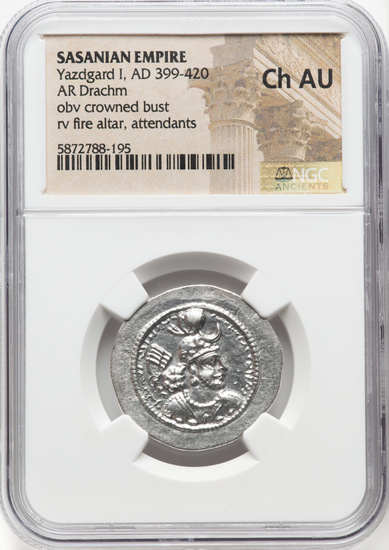Ancients: , ANCIENT LOTS. Oriental. Sasanian Kingdom. Yazdgard (Yazdgird) I (AD 399-420). Lot of three (3) AR drachms. NGC AU-Choice AU.... (Total: 3 coins)
ANCIENT LOTS. Oriental. Sasanian Kingdom. Yazdgard (Yazdgird) I (AD 399-420). Lot of three (3) AR drachms. NGC AU-Choice AU. Includes: Three AR drachms of Yazdgard I, various mints. Total of three (3) coins in lot. Yazdgard I, whose name means "God-made" in Pahlavi, presided over the Sasanian Empire in the first two decades of the 5th century, a period of prosperity and cultural renewal. In a seminal break from the empire’s traditional foreign policy, he pursued amicable relations with the Roman Empire. This unprecedented diplomacy included raising the future Emperor Theodosius II at the Sassanid court in Ctesiphon, earning Yazdgard I positive treatment Roman historians. Yazdgard I ended the persecution of Christians, recognizing the Nestorian Church and facilitated the patronage of Christianity within the Zoroastrian realm. Roman church officials were welcomed into Iran to help shape the development of an Iranian Church, which would declare its independence from Rome shortly after Yazdgard I’s death. To consolidate his authority, Yazdgard I strategically appointed members of the House of Suren to senior positions, a move aimed at neutralizing the rival Parthian nobility, who were responsible for the murder of his three predecessors. However, his peaceful stance towards Rome and support for Christianity provoked the ire of both the aristocracy and Zoroastrian clergy, culminating in his probable assassination in 420 AD. His coins bear a unique epithet, Ramshahr, meaning "peacekeeper", and he wears a distinctive crown, with a domed cloth and pearled tiara surmounted by a korymbos tied with two small floating ribbons, and a crescent moon above his forehead, sometimes beneath the korymbos. The waxing and waning of the moon is a key theme in the Avesta, the sacred text of Zoroastrianism, reflecting the cosmological roles of the three primary deities: Mah, the lunar recipient of prayers (yasht), Ahura Mazda, the Creator who made the phases of the moon, and Mithra, associated with cattle, which were thought to have given the moon its light. HID10510052018 © 2024 Heritage Auctions | All Rights Reserved
[ translate ]View it on
Sale price
Time, Location
Auction House
ANCIENT LOTS. Oriental. Sasanian Kingdom. Yazdgard (Yazdgird) I (AD 399-420). Lot of three (3) AR drachms. NGC AU-Choice AU. Includes: Three AR drachms of Yazdgard I, various mints. Total of three (3) coins in lot. Yazdgard I, whose name means "God-made" in Pahlavi, presided over the Sasanian Empire in the first two decades of the 5th century, a period of prosperity and cultural renewal. In a seminal break from the empire’s traditional foreign policy, he pursued amicable relations with the Roman Empire. This unprecedented diplomacy included raising the future Emperor Theodosius II at the Sassanid court in Ctesiphon, earning Yazdgard I positive treatment Roman historians. Yazdgard I ended the persecution of Christians, recognizing the Nestorian Church and facilitated the patronage of Christianity within the Zoroastrian realm. Roman church officials were welcomed into Iran to help shape the development of an Iranian Church, which would declare its independence from Rome shortly after Yazdgard I’s death. To consolidate his authority, Yazdgard I strategically appointed members of the House of Suren to senior positions, a move aimed at neutralizing the rival Parthian nobility, who were responsible for the murder of his three predecessors. However, his peaceful stance towards Rome and support for Christianity provoked the ire of both the aristocracy and Zoroastrian clergy, culminating in his probable assassination in 420 AD. His coins bear a unique epithet, Ramshahr, meaning "peacekeeper", and he wears a distinctive crown, with a domed cloth and pearled tiara surmounted by a korymbos tied with two small floating ribbons, and a crescent moon above his forehead, sometimes beneath the korymbos. The waxing and waning of the moon is a key theme in the Avesta, the sacred text of Zoroastrianism, reflecting the cosmological roles of the three primary deities: Mah, the lunar recipient of prayers (yasht), Ahura Mazda, the Creator who made the phases of the moon, and Mithra, associated with cattle, which were thought to have given the moon its light. HID10510052018 © 2024 Heritage Auctions | All Rights Reserved
[ translate ]


